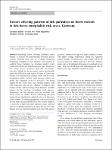Factors affecting patterns of tick parasitism on forest rodents in tick-borne encephalitis risk areas, Germany
Kiffner, Christian
Vor, Torsten
Hagedorn, Peter
Niedrig, Matthias
Rühe, Ferdinand
Identifying factors affecting individual vector burdens is essential for understanding infectious disease systems. Drawing upon data of a rodent monitoring programme conducted in nine different forest patches in southern Hesse, Germany, we developed models which predict tick (Ixodes spp. and Dermacentor spp.) burdens on two rodent species Apodemus flavicollis and Myodes glareolus. Models for the two rodent species were broadly similar but differed in some aspects. Patterns of Ixodes spp. burdens were influenced by extrinsic factors such as season, unexplained spatial variation (both species), relative humidity and vegetation cover (A. flavicollis). We found support for the ‘body mass’ (tick burdens increase with body mass/age) and for the ‘dilution’ hypothesis (tick burdens decline with increasing rodent densities) and little support for the ‘sex-bias’ hypothesis (both species). Surprisingly, roe deer densities were not correlated with larvae counts on rodents. Factors influencing the mean burden did not significantly explain the observed dispersion of tick counts. Co-feeding aggregations, which are essential for tick-borne disease transmission, were mainly found in A. flavicollis of high body mass trapped in areas with fast increase in spring temperatures. Locally, Dermacentor spp. appears to be an important parasite on A. flavicollis and M. glareolus. Dermacentor spp. was rather confined to areas with higher average temperatures during the vegetation period. Nymphs of Dermacentor spp. mainly fed on M. glareolus and were seldom found on A. flavicollis. Whereas Ixodes spp. is the dominant tick genus in woodlands of our study area, the distribution and epidemiological role of Dermacentor spp. should be monitored closely.
Dateien zu dieser Publikation
Keine Lizenzangabe
Verwandte Publikationen
Anzeige der Publikationen mit ähnlichem Titel, Autor, Urheber und Thema.
-
2008-05-05ZeitschriftenartikelFatal ulcerative colitis in a western lowland gorilla (Gorilla gorilla gorilla). Lankester, Felix; Mätz-Rensing, Kerstin; Kiyang, J.; Jensen, Siv Aina; Weiss, Sabrina; Leendertz, FabianA captive western lowland gorilla (Gorilla gorilla gorilla) presented with watery diarrhoea that progressed to become profuse and haemorrhagic. Faecal analyses revealed Balantidium (B.) coli trophozoites and salmonella-like ...
-
2010-12-01ZeitschriftenartikelWild Chimpanzees Infected with 5 Plasmodium Species Kaiser, Marco; Löwa, Anna; Ulrich, Markus; Ellerbrok, Heinz; Goffe, Adeelia S.; Blasse, Anja; Zommers, Zinta; Couacy-Hymann, Emmanuel; Babweteera, Fred; Zuberbühler, Klaus; Metzger, Sonja; Geidel, Sebastian; Boesch, Christophe; Gillespie, Thomas R.; Leendertz, FabianData are missing on the diversity of Plasmodium spp. infecting apes that live in their natural habitat, with limited possibility of human-mosquito-ape exchange. We surveyed Plasmodium spp. diversity in wild chimpanzees ...
-
2012-06-12ZeitschriftenartikelHigh Prevalence of Giardia duodenalis Assemblage B Infection and Association with Underweight in Rwandan Children Ignatius, Ralf; Gahutu, Jean Bosco; Klotz, Christian; Steininger, Christian; Shyirambere, Cyprien; Lyng, Michel; Musemakweri, Andre; Aebischer, Toni; Martus, Peter; Harms, Gundel; Mockenhaupt, Frank P.Background: Giardia duodenalis is highly endemic in East Africa but its effects on child health, particularly of submicroscopic infections, i.e., those below the threshold of microscopy, and of genetic subgroups ...

